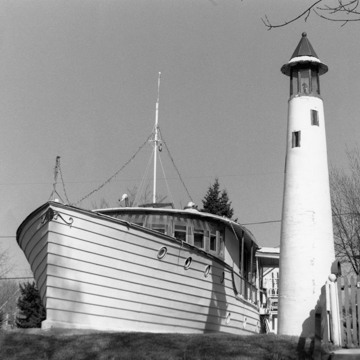When traveling salesman Edmund Gustorf needed a new house, he followed many Americans of the 1920s by indulging in an exotic architectural fantasy. But instead of mimicking a period style, he had his house built in the shape of a boat. Seventy-two feet long, fitted with portholes, life preservers, and running lights, the house resembles a vintage motor yacht. The “hull” is aluminum siding, and the “cabin” is wood paneling. Gustorf had a Green Bay boatyard precut pieces of the house, and then he assembled the parts on site atop a concrete basement. He named his new house the Landlubber. To complete the nautical theme, he built a miniature lighthouse, complete with rotating beacon, on the front lawn. In the “pilothouse” living room dark mahogany paneling, polished brass fittings, and oak flooring resemble a yacht’s interior. A ship’s wheel fits inside the arc of windows at the front of the room; the dining cabin opens aft of the pilothouse onto a sunny deck astern. Gustorf’s quarters, the house’s single bedroom, are crowded into the bow of the yacht, dimly lit by portholes. The entire house was lovingly restored in the late 1980s.
You are here
Edmund and Lotta Gustorf House, “Landlubber”
If SAH Archipedia has been useful to you, please consider supporting it.
SAH Archipedia tells the story of the United States through its buildings, landscapes, and cities. This freely available resource empowers the public with authoritative knowledge that deepens their understanding and appreciation of the built environment. But the Society of Architectural Historians, which created SAH Archipedia with University of Virginia Press, needs your support to maintain the high-caliber research, writing, photography, cartography, editing, design, and programming that make SAH Archipedia a trusted online resource available to all who value the history of place, heritage tourism, and learning.















